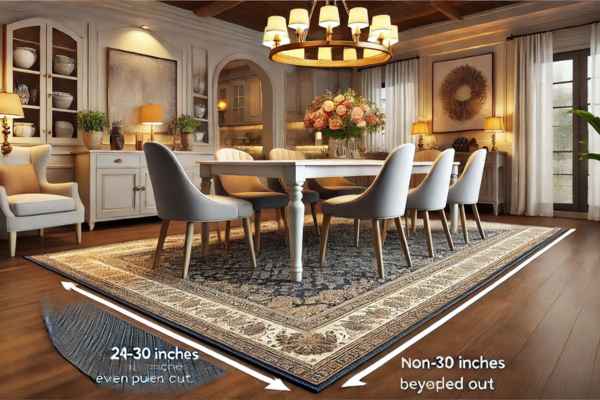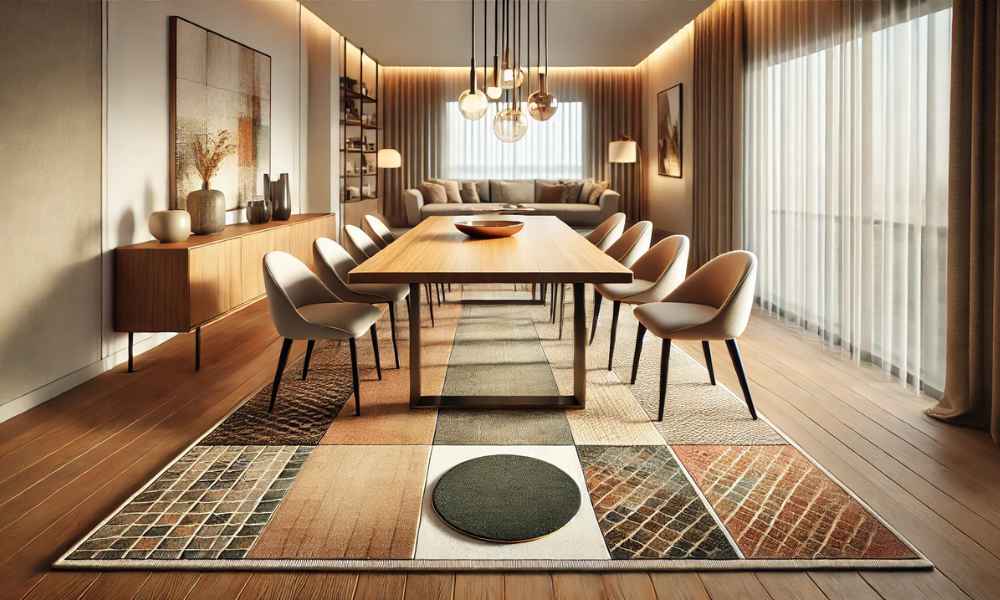A dining room rug is more than just an accessory—it anchors the space, defines the dining area, and adds warmth and texture to your decor. However, choosing the right size rug for a dining room can be a daunting task. If it’s too small, it disrupts the balance of the space. If it’s too large, it overwhelms the room. So, how do you determine the perfect rug size for your dining room? This guide will walk you through everything you need to know, from rug sizing principles to shape considerations, materials, and layout strategies.
Understanding Rug Sizing for Dining Rooms
The size of your dining room rug should complement the dimensions of your dining table while leaving ample space around it. A well-proportioned rug ensures that chairs remain on a flat surface, even when pulled out.
The general rule of thumb is to choose a rug that extends at least 24 inches beyond all sides of the table. This allows enough room for chairs to slide in and out without catching on the edges of the rug.
For example:
- A 6-seat dining table (about 36”–48” wide and 60”–72” long) pairs well with an 8’ x 10’ rug.
- An 8-seat dining table (about 40”–48” wide and 78”–96” long) fits an 9’ x 12’ rug.
- A 10-seat dining table (over 96” long) requires at least a 10’ x 14’ rug.
For smaller spaces, round or oval rugs can be an excellent alternative, especially for circular dining tables.
Choosing the Right Rug for Different Table Shapes

Different table shapes call for different rug styles. A mismatch between the table and rug shape can disrupt the aesthetic harmony of your dining area.
- Rectangular Tables: A rectangular rug is the best choice, as it mirrors the shape of the table and aligns well with the room’s natural flow.
- Round Tables: A round rug enhances the symmetry of a circular table, creating a cohesive and balanced look.
- Square Tables: A square rug works best, maintaining proportionality and defining the space without appearing too large or too small.
- Oval Tables: A rectangular or oval rug is ideal, offering both length and symmetry.
How to Ensure Chairs Stay on the Rug

One of the most common dining room rug mistakes is choosing a size that doesn’t accommodate the movement of chairs. If the rug is too small, chair legs will constantly slip off, creating instability and an uneven surface.
To prevent this:
- Extend the rug at least 24–30 inches beyond the table.
- If space allows, opt for an oversized rug to provide a luxurious feel.
- Ensure the rug has a non-slip pad underneath to prevent shifting and wrinkling.
A proper-sized rug enhances both functionality and comfort, allowing diners to move their chairs freely without feeling restricted.
Matching Your Rug to Your Dining Room Layout

Your dining room layout significantly influences your rug choice. Whether you have an open-concept space or a more enclosed dining area, the rug should integrate seamlessly into the room.
- Small Dining Spaces: If your dining area is compact, consider a lighter-colored rug to create an illusion of openness. A round rug can help soften the edges of the space.
- Large Dining Areas: An expansive dining room benefits from a generously sized rug that grounds the table and prevents the space from feeling empty or disconnected.
- Open-Concept Dining Rooms: A rug helps define the dining area within an open floor plan. Make sure the rug doesn’t compete with surrounding furniture but rather complements the overall flow.
Material and Pile Height Considerations

The dining room is a high-traffic area prone to spills and stains, so choosing the right rug material is crucial.
- Best Materials:
- Wool – Durable, stain-resistant, and naturally soft underfoot.
- Polypropylene – Budget-friendly, easy to clean, and resistant to moisture.
- Cotton – Lightweight and easy to wash, though less durable over time.
- Jute & Sisal – Eco-friendly and textured but may be harder to clean.
- Pile Height Considerations:
- Low-Pile Rugs – Ideal for dining rooms as they are easier to clean and don’t trap crumbs.
- High-Pile Rugs – Less suitable for dining areas due to difficulty in maintenance and chair movement restrictions.
Shape Matters: Finding the Right Rug Shape for Your Dining Area
The shape of your dining room rug should complement the table and enhance the overall layout of the space. A rectangular table pairs best with a rectangular rug, ensuring a balanced look. Round tables work beautifully with round rugs, creating a cohesive, symmetrical appearance. Square tables can be paired with either square or round rugs, depending on the room’s layout and design preferences. If you have an oval dining table, a rectangular or oval rug works well, provided there is enough space to accommodate chairs when pulled out. In open-concept spaces, where the dining area is part of a larger room, a well-chosen rug helps define the space, preventing it from blending into the surrounding areas. Matching the shape of your rug to your dining table ensures a harmonious, visually appealing setup.
Color, Pattern, and Style Considerations
The color and pattern of your dining room rug set the tone for the entire space. Neutral tones such as beige, gray, or cream offer timeless elegance and blend seamlessly with various decor styles. For those looking to make a bold statement, patterned rugs with geometric, floral, or abstract designs can add depth and personality to the room. When selecting a color, consider how it will interact with food spills and stains. Darker hues or multi-tonal patterns help mask inevitable dining mishaps, making maintenance easier. Additionally, the rug should complement existing furniture, wall colors, and flooring, creating a cohesive and inviting atmosphere. Whether you prefer a modern, minimalist look or a more traditional aesthetic, the right rug can enhance the overall style of your dining space.
Budget-Friendly Rug Shopping Tips
Finding the perfect dining room rug doesn’t have to break the bank. Start by determining your budget and exploring different materials that offer both durability and affordability. Synthetic fibers like polypropylene and polyester are cost-effective options that provide stain resistance and easy cleaning, making them ideal for high-traffic dining areas. Consider shopping at discount home stores, online retailers, or second-hand shops to find quality rugs at lower prices. Another budget-friendly approach is layering—a smaller, stylish rug can be placed over a larger, less expensive neutral rug to create a custom look without the hefty price tag. Always check for sales, clearance deals, and discount codes when purchasing a rug online to get the best value for your money.
Rug Pads and Their Importance
A rug pad is an essential but often overlooked component when selecting a dining room rug. It provides cushioning, prevents slipping, and extends the life of the rug by reducing wear and tear. Rug pads also protect hardwood and tile floors from scratches caused by chair movement. When choosing a rug pad, consider the material and thickness. Felt or rubber pads offer excellent grip and stability, ensuring that the rug stays in place even during frequent chair adjustments. A non-slip pad is particularly important for thinner rugs, preventing them from bunching up and creating tripping hazards. Investing in a quality rug pad enhances both safety and comfort in your dining area.
Seasonal Rug Swaps and Maintenance Tips
Changing rugs seasonally can refresh the look of your dining room while extending the lifespan of each rug. Lightweight, breathable rugs like flatweaves or natural fiber rugs work well in warmer months, adding an airy and casual feel. During colder seasons, plush, woolen rugs provide warmth and coziness, making the dining space feel more inviting. Regular maintenance is crucial to keep your rug looking its best. Vacuuming at least once a week prevents dust and food particles from settling into the fibers. For spills, immediate spot-cleaning with mild detergent and water can prevent stains from setting. Professional deep cleaning once a year helps maintain the rug’s longevity and freshness. Rotating the rug every few months ensures even wear, especially in high-traffic dining areas.
Alternative Solutions: What to Do If a Rug Doesn’t Fit?
Sometimes, a standard rug size just doesn’t work for a particular dining space. If a rug is too small, consider layering it over a larger, neutral-colored rug to create the illusion of a bigger surface. Alternatively, custom-cut rugs allow for a tailored fit, ensuring that every chair remains on the rug when pulled out. For those who prefer a minimalist approach, going rug-free is also an option. Well-polished hardwood, tile, or concrete floors can serve as a sleek alternative, eliminating concerns about stains or cleaning. A strategically placed runner or two smaller rugs can also define the dining space without the need for a traditional area rug.
Final Thoughts
Choosing the right size rug for your dining room is a balance between aesthetics, functionality, and practicality. From selecting the ideal shape and color to considering budget-friendly options and maintenance strategies, every detail plays a role in achieving a cohesive dining space. A well-sized rug enhances comfort, protects flooring, and elevates the overall ambiance of the room. Whether you opt for a classic wool rug, a patterned statement piece, or a simple, neutral design, the key is ensuring that it fits proportionally with your table and chairs. By taking the time to measure and explore various styles, you can find a rug that perfectly complements your dining area, making every meal a stylish and comfortable experience.
